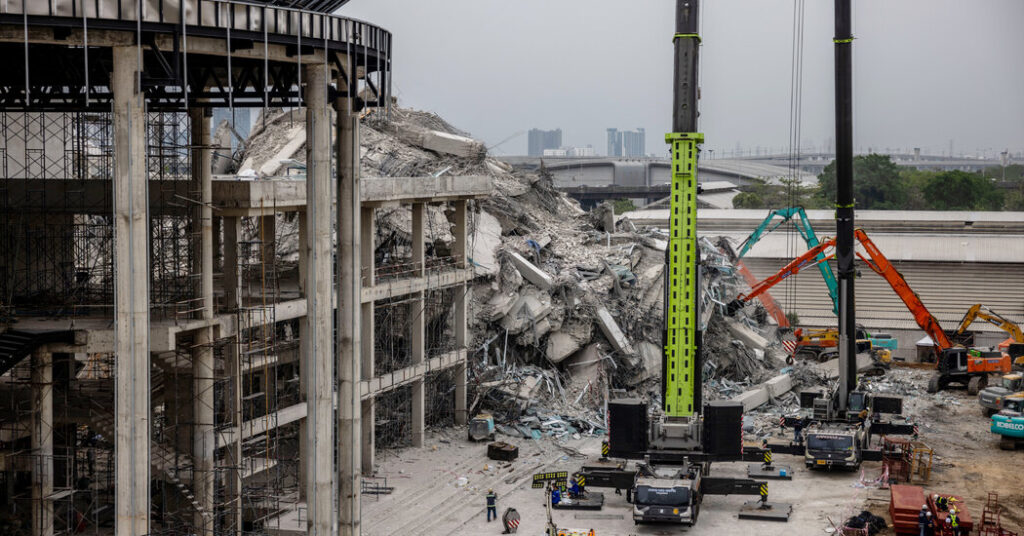The rescue teams at the collapsed office tower in Bangkok thought they’d found a miracle on Sunday night: a channel into the basement, leading to a wide-open space where workers still unaccounted for might have lived through Friday’s giant earthquake.
“We thought for sure we’d find someone,” said Piyalux Thinkaew, chief of operations for the Ruamkatanyu Foundation, one of Thailand’s leading emergency organizations. “It was a whole room. It was big.”
Around a dozen rescuers stepped in. They were from Thailand, China, the United States and Israel. They could see the foundation’s pillars holding strong. But the room was empty.
The next morning, another wisp of hope arrived when infrared sensors found potential signs of life. The recovery work fell silent. But after a while, there was nothing. No one was pulled out alive or dead on Monday by the time the clock ticked past the so-called golden window — the 72 hours in which survival is most likely.
“Hope is dimming,” Mr. Piyalux said. “We’re very disappointed.”
Was rescue becoming recovery? Not officially. Around 80 workers were still under the pile of chest-crushing rubble and steel that was tall enough to be seen from blocks away. Rescue workers said they were racing against time, as if 72 hours really meant 96, or maybe more.
The building had been partially finished, at a stage where the interior work involved what employees described as roughly an even mix of male and female workers. Many were in love. Husbands and wives, married for years, worked with young couples in fevered courtships.
Perhaps that’s why the sights and sounds on Monday seemed more urgent. After mostly probing the pile, to avoid disruption and to ensure a careful first sweep for life, a half dozen excavators pinched and punched at the edges all at once, their tweezerlike fingers grabbing at steel and concrete in a haphazard dance.
Maybe, deeper in, more signs of life would emerge.
Apichat Chaihlao, 32, said he was waiting for his girlfriend. Her name was Nayana Phimsan, and she was just 18. They were there together on Friday, for their first day of work after moving from another job. After lunch, he was a few floors above her, smoking, when he felt dizzy, saw the building swaying and ran out. A few of his friends didn’t make it.
“As long as they have not found them, I’ll believe she is still alive,” he said.
He described Ms. Nayana as strong and full of life, with a great sense of humor.
“I like to annoy her, tease her until she yells at me,” he said.
“Now it’s so empty,” he added. “I don’t want to go home at all.”
Nearby, Samai Lapphet, 65, said he would keep an open mind until the end of the week — maybe his eldest son, Kittisuk, 40, an electrician, had survived. Kittisuk had met his girlfriend there at work. She was stuck in the ruins, too. They were supposed to marry.
“The most important thing is for him to be found,” Mr. Samai said, “so I can see him again.”
For him and others, waiting for news was now a team effort. Many submitted DNA samples to the police so that remains of relatives could be identified, even if very little could be found. Mothers at the site were joined by brothers, cousins, uncles and friends.
On the sidewalk, two teenage girls sat on cardboard and tried to comfort older relatives. In a park, a half-dozen men with connections to someone at the work site gathered on a blanket with a pink pillow covered in cartoon kittens.
All around them, the street where the building entrance would have been had become a community. Tents had multiplied with volunteer assistance, with food for relatives, pallets of water for rescuers and the occasional mental health worker offering support. Each group wore a different uniform: firefighters in red and the police in blue. Mr. Thinkaew and his team wore green jumpsuits with gold lettering. Others wore neon orange or yellow.
The main color to be found, the color that defined everything, was gray, as dust settled on everything and everyone. Something as solid as a giant tower had been reduced to particles, pulled into lungs and eyes with the smell of pulverized concrete.
Somewhere in there, though, were loved ones.
Under a sky blue tarp with a view of tangled steel, Supattra Penjan, 40, dabbed her eyes with a white washcloth. Her son, Worawut Triwut, was 18, she said, a recent graduate, a joker, a lover of soccer. She showed us a photo taken at 7:32 a.m. on the day of the earthquake. He looked happy in his orange vest, his hair combed back, standing near his best friend and co-worker.
He’d been working at the building for a week.
“As a mom, I keep this hope in me that he is still alive,” she said. “But I am also starting to prepare myself for the worst.”
https://www.nytimes.com/2025/03/31/world/asia/collapsed-bangkok-building-rescue-earthquake.html


